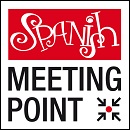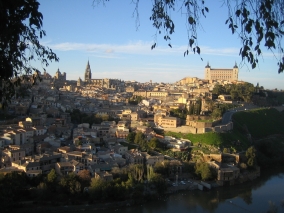Spanish schools and accommodation to study Spanish in Spain
Recent posts
Last schools
introduced
introduced
0 Accommodation

1 Spanish schools

Learning Spanish in Toledo. The tourist guide to study your Spanish course.
General Information. 83,000 inhabitants, albeit with a large floating population due to tourism and its status as an administrative capital. 70 kilometres to the south of Madrid. It is the capital of the Autonomous Community of Castile-La Mancha. Toledo is circled by the Tagus River (Río Tajo in Spanish) and a walled area, hence its historical importance as a fortified city. Toledo is known as "The City of Three Cultures", a name which refers to the Christian, Jewish and Islamic communities that coexisted for centuries within its walls, each of which is represented by a rich historical heritage. Toledo is also known as "The Imperial City", due to having been the headquarters of the court of Charles I of Spain. Its old quarter is very well preserved, and a stroll through the streets of Toledo is like stepping back into the Middle Ages. Toledo is home to one of the sites of the University of Castile-La Mancha. Toledo is a very attractive place to study Spanish with some language schools offering a wide range of courses.
Surrounding Areas. Aranjuez (50 kilometres), which was designated a Royal Site by King Philip II in 1560. It is famous for its Royal Palace and Gardens, declared a World Heritage Site in 2001. Consuegra (65 kilometres), which forms part of the Don Quixote Route (Ruta de Don Quijote de la Mancha). On an uphill road leading out of the town there is a line of 12 restored windmills dating from the 16th century and a castle whose construction began in the 10th century under the Caliphate of Córdoba; from the top of the hill you can enjoy a panoramic view of a vast plain with the windmills of Alcázar de San Juan in the far distance. On the road to Madrid (70 kilometres) you will find the Carranque Archaeology Park. Las Ventas con Peña Aguilera (40 kilometres) is a village worth visiting for the local cuisine, based on venison, and the numerous shops selling handmade leather items and accessories, which also open on Sundays and public holidays.
World Heritage Site. The whole city was declared a World Heritage Site by UNESCO in 1987.
Main Sights. The entire old quarter is a veritable monumental ensemble, comprising a large number of churches, synagogues and mosques. El Alcázar, the old citadel at the top of the hill on which the city is perched, with magnificent panoramic views, and which has been a Roman, Visigoth and Arab fortress. The Primate Cathedral (Catedral Primada), whose construction began in 1226 and whose 90-metre-high tower was completed in the 15th century. One of the treasures to be found inside the cathedral is La Custodia; this huge gold and silver monstrance, handcrafted by Enrique de Arfe in 1524, has been used in the Corpus Christi procession since 1595. The Monastery of Saint John of the Kings (Monasterio de San Juan de los Reyes), whose church was built to house the dynastic pantheon of Isabella I of Castile. The Sinagoga del Tránsito, a 14th century Jewish synagogue. The Mezquita de Cristo de la Luz, the only remaining former mosque. Almost anywhere in the old quarter is a suitable spot for contemplating Toledo, whether it be one of the many lookout points or squares such as Zocodover, Santa Clara, San Cipriano... Several illustrious artists and men of letters, including Buñuel, Dalí, Lorca and Alberti, spoke about how they loved to wander aimlessly through the streets of the old town. For visitors who want to explore Toledo and learn about its history, there are numerous guided walking tours, both during the day and at night, such as Romantic Toledo (featuring the typical wood-covered passageways known as cobertizos), Jewish Toledo, Moorish Toledo..... A walk along the bank of the Tagus is a good way to see the city from nearly all points of the compass, while on the other side of the valley, the area around the Shrine of the Virgin of the Valley (Ermita de la Virgen del Valle) offers panoramic views of the city that no visitor can afford to miss. The monuments are a major attraction for the many students who decide to study Spanish in Toledo.
Culture. The most important events are the Jazz Festival (Jazz Ciudad de Toledo, last week of August), and the International Music Festival (Festival Internacional de Música de Toledo, May-June), a series of classical music concerts held at both indoor and outdoor venues. There are numerous museums in Toledo: the Museo de El Greco, built in the early 20th century and devoted to the works of the Spanish Renaissance artist, who was born in Crete but spent over half his life in Toledo; the Museo Sefardí, housed in the Sinagoga del Tránsito, focuses on Sephardic Jewish culture; the Museo de Santa Cruz, featuring important archaeological exhibits and art collections; and the Museo del Ejército, a military museum located in the El Alcázar. The city's most important theatre is the Teatro de Rojas.
Shopping. The old quarter is full of shops selling a range of typical souvenirs, such as swords, damascene items, handicrafts and confectionery, marzipan being a particular speciality. Toledo also has a large shopping centre called Luz del Tajo, where you will find all the main fashion brands.
Gastronomy. If you wish to sample the local tapas, we recommend the following bars: La Abadía, on Calle Nuñez de Arce; Alfileritos 24; El Trebol, next to Plaza de Zocodover; La Tabernita, on Calle Santa Fe; Ludeña, in Plaza de la Magdalena; La Naviera, near Calle Santo Tomé. All these establishments are located in the historic city centre and most of them are historical buildings of considerable charm. The Santa Teresa neighbourhood is outside the old quarter but also offers a good selection of tapas bars. Toledo is famous for its roasted meat and game dishes, especially lamb, venison and partridge. The most typical regional dishes are estofado de perdiz (braised partridge), judías con perdiz (bean and partridge stew) asado de cordero (roast lamb), cochifrito (deep-fried lamb made into a stew), as well as various venison specialities. All of these dishes are on offer at La Ermita, a quaint restaurant situated on the other side of the valley. Marzipan is the most representative item of confectionery, and there are also fine Manchego cheeses and good wines with the Méntrida designation of origin.
Sports. The Javier Lozano Cid municipal sports hall can hold up to 1,500 people, and you can play or learn almost any sport there. The local football team, Club Deportivo Toledo, play at Estadio Salto del Caballo. Toledo also has other sports centres and swimming pools, and there are several golf courses nearby.
Fiestas. The most well-known is Corpus Christi; the city's streets are specially decorated for the celebration of this important religious festival, which reaches its climax with a solemn procession featuring Enrique de Arfe's stunning masterpiece, the massive Custodia. Between Holy Week and Whitsun, the city organizes several pilgrimages to various local shrines, the most important being the Romería de la Virgen del Valle (1st May).
Transport. There is a sightseeing bus which leaves from Plaza de Zocodover and takes in all the most emblematic places of interest. There is also a tourist train which departs from the same square and skirts around Toledo, traversing the valley which borders the Tagus. It is easy to get from Toledo to other Spanish cities by train or by using the various coach services.
Nightlife. Students who decide to study Spanish in Toledo will discover a very active nightlife. In and around Calle Alfileritos we find bars with a wide range of musical styles. One of the most unusual is Círculo de Arte, an old church converted into a cafeteria-bar which turns into a discotheque at weekends. Then there is Garcilaso, formerly a synagogue, or the modern Bar Pícaro, with regular live performances, but there are many others. For a more relaxing evening in a privileged setting with magnificent views of Toledo, it is worth heading across the river and into the valley, where you will find a number of cigaralles (the name given to the traditional country houses situated near the banks of the Tagus), many of which have been converted into outdoor bars, restaurants and hotels, among them Venta del Alma, Terraza de Recaredo and Cigarral de Carabantes. The Santa Teresa neighbourhood is the best area for partying into the early hours at weekends. A late-night alternative during the summer months is the riverside area of outdoor bars known as Las Terrazas de La Peraleda, which start to get busy at two or three in the morning.
Surrounding Areas. Aranjuez (50 kilometres), which was designated a Royal Site by King Philip II in 1560. It is famous for its Royal Palace and Gardens, declared a World Heritage Site in 2001. Consuegra (65 kilometres), which forms part of the Don Quixote Route (Ruta de Don Quijote de la Mancha). On an uphill road leading out of the town there is a line of 12 restored windmills dating from the 16th century and a castle whose construction began in the 10th century under the Caliphate of Córdoba; from the top of the hill you can enjoy a panoramic view of a vast plain with the windmills of Alcázar de San Juan in the far distance. On the road to Madrid (70 kilometres) you will find the Carranque Archaeology Park. Las Ventas con Peña Aguilera (40 kilometres) is a village worth visiting for the local cuisine, based on venison, and the numerous shops selling handmade leather items and accessories, which also open on Sundays and public holidays.
World Heritage Site. The whole city was declared a World Heritage Site by UNESCO in 1987.
Main Sights. The entire old quarter is a veritable monumental ensemble, comprising a large number of churches, synagogues and mosques. El Alcázar, the old citadel at the top of the hill on which the city is perched, with magnificent panoramic views, and which has been a Roman, Visigoth and Arab fortress. The Primate Cathedral (Catedral Primada), whose construction began in 1226 and whose 90-metre-high tower was completed in the 15th century. One of the treasures to be found inside the cathedral is La Custodia; this huge gold and silver monstrance, handcrafted by Enrique de Arfe in 1524, has been used in the Corpus Christi procession since 1595. The Monastery of Saint John of the Kings (Monasterio de San Juan de los Reyes), whose church was built to house the dynastic pantheon of Isabella I of Castile. The Sinagoga del Tránsito, a 14th century Jewish synagogue. The Mezquita de Cristo de la Luz, the only remaining former mosque. Almost anywhere in the old quarter is a suitable spot for contemplating Toledo, whether it be one of the many lookout points or squares such as Zocodover, Santa Clara, San Cipriano... Several illustrious artists and men of letters, including Buñuel, Dalí, Lorca and Alberti, spoke about how they loved to wander aimlessly through the streets of the old town. For visitors who want to explore Toledo and learn about its history, there are numerous guided walking tours, both during the day and at night, such as Romantic Toledo (featuring the typical wood-covered passageways known as cobertizos), Jewish Toledo, Moorish Toledo..... A walk along the bank of the Tagus is a good way to see the city from nearly all points of the compass, while on the other side of the valley, the area around the Shrine of the Virgin of the Valley (Ermita de la Virgen del Valle) offers panoramic views of the city that no visitor can afford to miss. The monuments are a major attraction for the many students who decide to study Spanish in Toledo.
Culture. The most important events are the Jazz Festival (Jazz Ciudad de Toledo, last week of August), and the International Music Festival (Festival Internacional de Música de Toledo, May-June), a series of classical music concerts held at both indoor and outdoor venues. There are numerous museums in Toledo: the Museo de El Greco, built in the early 20th century and devoted to the works of the Spanish Renaissance artist, who was born in Crete but spent over half his life in Toledo; the Museo Sefardí, housed in the Sinagoga del Tránsito, focuses on Sephardic Jewish culture; the Museo de Santa Cruz, featuring important archaeological exhibits and art collections; and the Museo del Ejército, a military museum located in the El Alcázar. The city's most important theatre is the Teatro de Rojas.
Shopping. The old quarter is full of shops selling a range of typical souvenirs, such as swords, damascene items, handicrafts and confectionery, marzipan being a particular speciality. Toledo also has a large shopping centre called Luz del Tajo, where you will find all the main fashion brands.
Gastronomy. If you wish to sample the local tapas, we recommend the following bars: La Abadía, on Calle Nuñez de Arce; Alfileritos 24; El Trebol, next to Plaza de Zocodover; La Tabernita, on Calle Santa Fe; Ludeña, in Plaza de la Magdalena; La Naviera, near Calle Santo Tomé. All these establishments are located in the historic city centre and most of them are historical buildings of considerable charm. The Santa Teresa neighbourhood is outside the old quarter but also offers a good selection of tapas bars. Toledo is famous for its roasted meat and game dishes, especially lamb, venison and partridge. The most typical regional dishes are estofado de perdiz (braised partridge), judías con perdiz (bean and partridge stew) asado de cordero (roast lamb), cochifrito (deep-fried lamb made into a stew), as well as various venison specialities. All of these dishes are on offer at La Ermita, a quaint restaurant situated on the other side of the valley. Marzipan is the most representative item of confectionery, and there are also fine Manchego cheeses and good wines with the Méntrida designation of origin.
Sports. The Javier Lozano Cid municipal sports hall can hold up to 1,500 people, and you can play or learn almost any sport there. The local football team, Club Deportivo Toledo, play at Estadio Salto del Caballo. Toledo also has other sports centres and swimming pools, and there are several golf courses nearby.
Fiestas. The most well-known is Corpus Christi; the city's streets are specially decorated for the celebration of this important religious festival, which reaches its climax with a solemn procession featuring Enrique de Arfe's stunning masterpiece, the massive Custodia. Between Holy Week and Whitsun, the city organizes several pilgrimages to various local shrines, the most important being the Romería de la Virgen del Valle (1st May).
Transport. There is a sightseeing bus which leaves from Plaza de Zocodover and takes in all the most emblematic places of interest. There is also a tourist train which departs from the same square and skirts around Toledo, traversing the valley which borders the Tagus. It is easy to get from Toledo to other Spanish cities by train or by using the various coach services.
Nightlife. Students who decide to study Spanish in Toledo will discover a very active nightlife. In and around Calle Alfileritos we find bars with a wide range of musical styles. One of the most unusual is Círculo de Arte, an old church converted into a cafeteria-bar which turns into a discotheque at weekends. Then there is Garcilaso, formerly a synagogue, or the modern Bar Pícaro, with regular live performances, but there are many others. For a more relaxing evening in a privileged setting with magnificent views of Toledo, it is worth heading across the river and into the valley, where you will find a number of cigaralles (the name given to the traditional country houses situated near the banks of the Tagus), many of which have been converted into outdoor bars, restaurants and hotels, among them Venta del Alma, Terraza de Recaredo and Cigarral de Carabantes. The Santa Teresa neighbourhood is the best area for partying into the early hours at weekends. A late-night alternative during the summer months is the riverside area of outdoor bars known as Las Terrazas de La Peraleda, which start to get busy at two or three in the morning.
© TEXT: SPANISH IN TOUR.
VIDEO: Patronato de Turismo de Toledo
VIDEO: Patronato de Turismo de Toledo
























